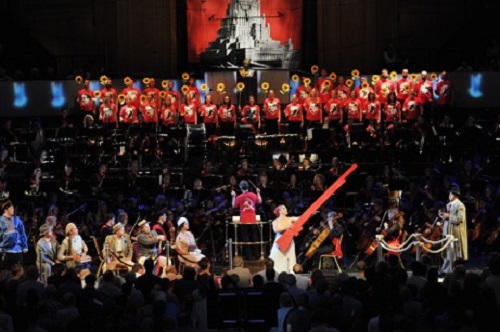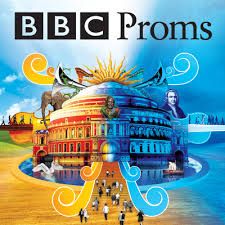 United Kingdom Prom 53, Bartók, Mozart, Shostakovich: David Fray (piano); soloists; Philharmonia Voices; Philharmonia Orchestra/Esa-Pekka Salonen. Royal Albert Hall, London. 24.8.2015 (CC)
United Kingdom Prom 53, Bartók, Mozart, Shostakovich: David Fray (piano); soloists; Philharmonia Voices; Philharmonia Orchestra/Esa-Pekka Salonen. Royal Albert Hall, London. 24.8.2015 (CC)

conducted by Esa-Pekka Salonen
c BBC/Chris Christodoulou
Bartók – The Miraculous Mandarin
Mozart – Piano Concerto in C minor, K 491
Shostakovich (orch McBurney) – Orango – Prologue (first Proms performance)
Orango – cast:
Orango: Ivan Novoselov
Foreign Visitors to Moscow
Armand Fleury (French embryologist): Alexander Shagun (tenor)
Renée (his daughter): Natalia Yakimova (mezzo)
First Foreigner: Vladimir Bobokin (tenor)
Second Foreigner: Oleg Losev (tenor)
Paul Mâche (French reporter): Alexander Trifomov (tenor)
Suzanna: Natalia Pavlova (soprano)
Soviet Citizens
Bass (Commissar): Yuri Yevchuk (bass)
Guard: Lev Elgardt (bass)
Master of Ceremonies: Denis Beganski (bass-baritone)
Nastya Terpsikhorova: Rosie Kay (dancer)
Zoologist: Dmitro Kolyeushko
Creatives:
Stage Director: Irina Brown
Stage/Video Design: Louis Brown
Movement Director: Rosie Kay
Lighting Design: Bernie Davis
This was a fascinating Prom, and easily the finest I have experienced so far this season. It was not sold out, which was a shame. Perhaps the more obscure second half – of which more soon – kept people away. Or maybe they should have read my colleague Dan Morgan’s excellent, perceptive review of the DG recording, a review that provides background aplenty, informed comment and great enthusiasm. Whatever the case, the nonetheless large audience had a ball.
For me Bartók’s great ballet The Miraculous Mandarin always evokes memories of several performances by Pierre Boulez in London in the 1980s. This piece certainly seemed to be one favoured by the modernist high priest-turned-conductor, and the results were always pointed and visceral. The Albert Hall’s acoustics are hardly the most helpful when it comes to precision engineered rhythms, even when the orchestra is encouraged by Salonen’s characteristic over-the-shoulder razor downbeats. Great dissonant outbursts were covered in sonic velvet. Far more successful were the whispered tensions of the storyline. The high string lines were superb, as were the clarinet solos of Mark van de Wiel and the oboe contributions of Christopher Cowie; there was also a lovely passage with the Philharmonia Voices.
In keeping with the blunting of the score were rather too controlled trombone glissandi and a resultant loss of grotesquerie. The final section includes a wild dance that, finally, found some sense of real abandon.
David Fray is an interesting pianist who first came my way with a disc coupling Bach and Boulez on Virgin Classics (85787); more recently, he performed the Bach two-keyboard concerto, BWV 1061 in C major with Frank Braley and the Lausanne Chamber Orchestra on a two-DVD set of all the Bach “piano” concertos (Martha Argerich and friends, BelAir Classiques BAC115). Interestingly, Fray’s style in Mozart’s C minor Concerto which was on display on this occasion was understated, whereas Salonen was obviously out to underline the powerful, almost Beethovenian orchestral exposition. Fray plays with a precise articulation that is reminiscent of Glenn Gould, and his interactions with the Philharmonia’s delightful woodwind section were pure joy. Playing very close to the keys (almost Bachian, one might argue), Fray’s was an intimate view that might have tended towards the understated in lesser hands. It was a pity that Salonen underplayed the Harmoniemusik aspect of some of the wind writing, but this remained an interesting performance, illuminated by Fray’s use of Paul Badura-Skoda’s fascinatingly inventive first movement cadenza.
The real draw of the evening was surely the Shostakovich Prologue (there is no more) to Orango. This is Shostakovich in Moskva, Cheryomushki mode. The story, as it was to be, centres on a hybrid half-ape, half-man who went on to become a journalist before ending up as a circus attraction. The setting is the steps to the never-built Palace of the Soviets. The half-hour piece, commissioned in 1932 for the 15th anniversary of the October Revolution, never saw the light of day and it was up to Gerald McBurney to flesh out the score. Premiered in Los Angeles in 2011 (by Salonen and his then-orchestra, the Los Angeles Philharmonic), the music recycles parts of the ballet The Bolt. McBurney points to influences and semi-quotations in the piece that should give some idea: Boris Godunov and Tchaikovsky are prime amongst them. The piece is a virtuoso display of how genius approaches vapid frippery and somehow transmutes it into something more, whilst not for a second losing its sense of buffoonish hilarity. Western journalists, clearly from a Western Otherworld, record the scene.
Irina Brown’s staging was excellently conceived for the Albert Hall space, with projections, as well as entrances of characters, from all angles. The back of the stage was used for projections (including bedbugs!) and there was a lovely dance from Rosie Kay as Nastya Terpsikhorova. Plenty of flag waving from the cast and, indeed, from the Prommers added to the fun. The vocal contributions were generally excellent, especially soprano Natalia Pavlova’s Suzanna. It was a pity, then, that Belorussian bass-baritone Denis Beganski’s Master of Ceremonies was under-projected, particularly in the later stages (although his stage presence and movements were extremely present and energetic). I wonder if this opera snippet is the only place in opera where there is an aria for a zoologist? The aria here was delivered deliciously by tenor Dmitro Kolueushko. And of course there is the apeman himself, clad in a rather camp, and somewhat hairy outfit; the part was taken with proper aplomb by baritone Ivan Novoselov.
The cast was taken from the Mariinsky Theatre; a nice touch was the music folders of the Philharmonia Voices with “Pravda” (the official Soviet newspaper) written on them. The Philharmonia players seemed to have just as much fun as the chorus, directed by a vigorous, now red T-shirted Salonen. The performance revealed a (deliberately) raw side to the Philharmonia, delivering at one point a raucous march that could only have come from the pen of Shostakovich. A lot of the score is decidedly Chaplinesque.
Predictably perhaps, the audience response was ecstatic, but for once it was justified. Salonen’s exploratory nature continues to bring forth fruit in both programming and delivery; not for him any hiding behind standard repertoire. Long may his relationship with the Philharmonia continue.
Colin Clarke
